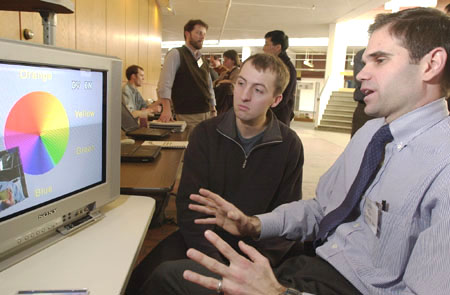Multimedia Fair sends out clear message
Education should drive the coming changes

Harvard computer experts got a glimpse of an educational future filled with virtual experiences and real-time information-gathering last week, along with a warning that education, not technology, should drive the coming changes.
The view of things to come was compliments of a panel discussion on the future of technology in education at last week’s 7th Annual ABCD Multimedia Fair: “Building Blocks of Learning.”
The six-hour fair, held at the Science Center, attracted about 100 computer personnel from departments across the University for presentations on subjects ranging from streaming audio to the role of technology in education.
The day-ending panel discussion presented a future in which the Internet, computers, and other technology enhance rather than replace the current educational experience.
What that means for students is experiencing, among other things, virtual trading on a vitual stock floor – so they can hear the noise and feel the pressure before taking that first job as a trader. And it means being able to better visualize what’s happening at the molecular level in science, through the use of three-dimensional imaging, some of which is already in use today.
It means students having a broader, deeper understanding of their subjects when they leave school, enriched by virtual trips under the sea, to outer space, and into the human body. And, most likely, it means changes that we can’t imagine right now.
“I think it will be a very exciting time, and it will be very different,” said Lucia Lovison-Golob, who teaches geographical information science at the Harvard Extension School. “[Education] will be very personalized, ‘on demand,’ anyplace to anyplace and anytime to anytime.”
While predictions of the beneficial uses of technology abounded, panelists also warned that students who tune into classes via distance learning today report feelings of isolation. They also warned that we should learn from the past, where sometimes excitement over the potential for new computers drove purchases and programs even before the educational use of the technology had been figured out. In short, they warned that the driving force in all technological change should be the desire to enhance learning, not to use new gadgets.
“Technology is the tool, not the ends. We have to keep that in mind or [the technology] will not get used,” said Don Bialek, adjunct lecturer in management at the School of Public Health.
Bialek said most use of the Internet for teaching today is asynchronous – happening at a time different from the actual classroom instruction, such as in a videotaped lecture. It is also not collaborative because the instructor and student often don’t work together.
That must change, he said, so that education becomes synchronous, using videoconferencing and other methods to bring distant students into the classroom in real time. Another feature will be self-paced learning.
Bialek drew an analogy between the early days of television, when the first programs were adapted from radio. Right now, he said, what we’re seeing is the viewing of taped lectures over the Internet, because it reflects what we do now. In the future, as in the future of television, the use of technology in education will evolve – probably in ways that we can’t predict – so that it best uses the potential of the new equipment.
Paul Bergen, instructional computing group manager for the Faculty of Arts and Sciences, said educators shouldn’t lose sight of the fact that the best education has always depended on one-on-one contact between a teacher and a student, and he doubted that would change.
“The best scenario for education will always be two people talking together,” Bergen said.
Several participants said that the new ways of teaching will make more work for instructors. In addition to class lectures, they have to prepare materials for Web pages, host Internet-based chats with far-flung students, respond to e-mail, and respond to a whole host of new challenges.
“Teachers will have more work to do,” Lovison-Golob said. “Before you had to deal with the classroom, now you have to provide personal instruction to 30 or 200 people at their own time and places.”
In addition to the look ahead, attendees at the multimedia fair were given a look at what’s going on at Harvard today.
University Information Services (UIS) is hosting a new streaming video service for instructors who want their students to view video via the Internet. Video streaming technology provides video over computer lines at the same time as it is displayed on a computer. This technology avoids the lengthy process of having to download the entire video and then view it.
Susan Delellis, of UIS, said the only thing the receiving person would have to have on their computer is software that plays videos. The service, which is currently in a pilot phase, is free. UIS also has facilities for converting video to a digital format.
“What we’re seeing now is the use of lectures, the use of video events and things that help in the learning process,” Delellis said.




